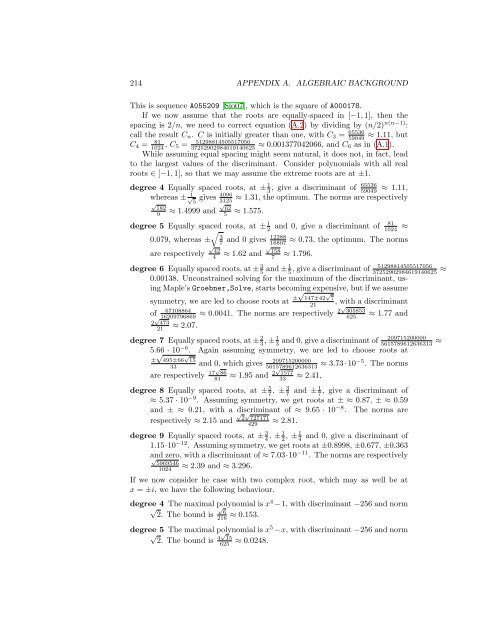Contents - Student subdomain for University of Bath
Contents - Student subdomain for University of Bath
Contents - Student subdomain for University of Bath
Create successful ePaper yourself
Turn your PDF publications into a flip-book with our unique Google optimized e-Paper software.
214 APPENDIX A. ALGEBRAIC BACKGROUND<br />
This is sequence A055209 [Slo07], which is the square <strong>of</strong> A000178.<br />
If we now assume that the roots are equally-spaced in [−1, 1], then the<br />
spacing is 2/n, we need to correct equation (A.2) by dividing by (n/2) n(n−1) :<br />
call the result C n . C is initially greater than one, with C 3 = 65536<br />
59049<br />
≈ 1.11, but<br />
C 4 = 81<br />
1024 , C 5 = 51298814505517056<br />
37252902984619140625 ≈ 0.001377042066, and C 6 as in (A.1).<br />
While assuming equal spacing might seem natural, it does not, in fact, lead<br />
to the largest values <strong>of</strong> the discriminant. Consider polynomials with all real<br />
roots ∈ [−1, 1], so that we may assume the extreme roots are at ±1.<br />
degree 4 Equally spaced roots, at ± 1 65536<br />
3<br />
, give a discriminant <strong>of</strong><br />
59049 ≈ 1.11,<br />
whereas ± √ 1 5<br />
gives 4096<br />
3125<br />
≈ 1.31, the optimum. The norms are respectively<br />
√<br />
182<br />
9<br />
≈ 1.4999 and √ 62<br />
5<br />
≈ 1.575.<br />
degree 5 Equally spaced roots, at ± 1 2 and 0, give a discriminant <strong>of</strong> 81<br />
√<br />
1024 ≈<br />
3<br />
12288<br />
0.079, whereas ±<br />
7<br />
and 0 gives<br />
16807<br />
≈ 0.73, the optimum. The norms<br />
are respectively √ 42<br />
4<br />
≈ 1.62 and √ 158<br />
7<br />
≈ 1.796.<br />
degree 6 Equally spaced roots, at ± 3 5 and ± 1 5 , give a discriminant <strong>of</strong> 51298814505517056<br />
37252902984619140625 ≈<br />
0.00138. Unconstrained solving <strong>for</strong> the maximum <strong>of</strong> the discriminant, using<br />
Maple’s Groebner,Solve, starts becoming √ expensive, but if we assume<br />
symmetry, we are led to choose roots at ± 147±42 √ 7<br />
21<br />
, with a discriminant<br />
67108864<br />
<strong>of</strong><br />
16209796869 ≈ 0.0041. The norms are respectively 2√ 305853<br />
625<br />
≈ 1.77 and<br />
2 √ 473<br />
21<br />
≈ 2.07.<br />
degree 7 Equally spaced roots, at ± 2 3 , ± 1 3 and 0, give a discriminant <strong>of</strong> 209715200000<br />
5.66 √ · 10 −6 . Again assuming symmetry, we are led to choose roots at<br />
± 495±66 √ 15<br />
209715200000<br />
33<br />
and 0, which gives<br />
5615789612636313 ≈ 3.73 · 10−5 . The norms<br />
are respectively 17√ 86<br />
81<br />
≈ 1.95 and 2√ 1577<br />
33<br />
≈ 2.41,<br />
degree 8 Equally spaced roots, at ± 5 7 , ± 3 7<br />
and ± 1 7<br />
, give a discriminant <strong>of</strong><br />
≈ 5.37 · 10 −9 . Assuming symmetry, we get roots at ± ≈ 0.87, ± ≈ 0.59<br />
and ± ≈ 0.21, with a discriminant <strong>of</strong> ≈ 9.65 · 10 −8 . The norms are<br />
respectively ≈ 2.15 and √ 2 √ 727171<br />
429<br />
≈ 2.81.<br />
degree 9 Equally spaced roots, at ± 3 4 , ± 1 2 , ± 1 4<br />
and 0, give a discriminant <strong>of</strong><br />
1.15·10 −12 . Assuming symmetry, we get roots at ±0.8998, ±0.677, ±0.363<br />
and zero, with a discriminant <strong>of</strong> ≈ 7.03·10 −11 . The norms are respectively<br />
√<br />
5969546<br />
1024<br />
≈ 2.39 and ≈ 3.296.<br />
If we now consider he case with two complex root, which may as well be at<br />
x = ±i, we have the following behaviour.<br />
degree 4 The maximal polynomial is x 4 −1, with discriminant −256 and norm<br />
√<br />
2. The bound is<br />
√<br />
6<br />
216 ≈ 0.153.<br />
degree 5 The maximal polynomial is x 5 −x, with discriminant −256 and norm<br />
√<br />
2. The bound is<br />
4 √ 15<br />
625 ≈ 0.0248.<br />
5615789612636313 ≈












![[Luyben] Process Mod.. - Student subdomain for University of Bath](https://img.yumpu.com/26471077/1/171x260/luyben-process-mod-student-subdomain-for-university-of-bath.jpg?quality=85)



